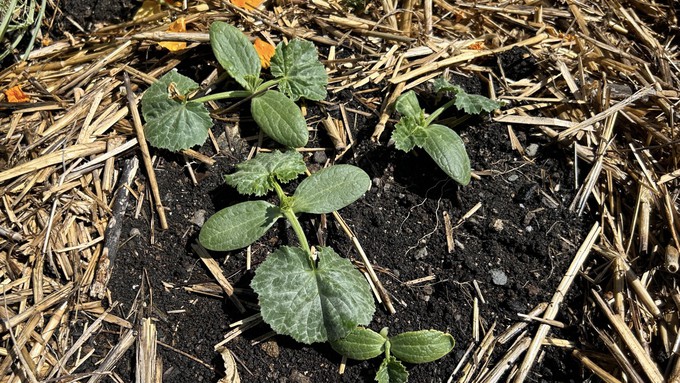
June starts with blast of summer heat (and warm nights)

There's still time to plant summer squash from seed, as well as melons, pumpkins and winter squash. Kathy Morrison
Thanks to a ridge of high pressure, our first of week of June will feel more like the last week of August.
According to the National Weather Service, Sacramento will jump from the high 80s to more than 100 degrees – in a hurry. The forecast calls for a high of 88 on Monday (June 3) and 104 on Wednesday (June 5).
Normal for this week: 87 degrees.
Keeping us hot will be unusually warm nights. The expected overnight low on Wednesday is 69 degrees – 13 degrees warmer than average for early June.
Fortunately, this heat spike is short. According to the weather service, Sacramento will be comfortably back to almost normal (and highs in the low 90s) by next weekend.
In the meantime, take care of chores in the morning. That includes irrigation; all this warmth makes your plants thirsty.
* Warm weather brings rapid growth in the vegetable garden, with tomatoes and squash enjoying the heat. Deep-water, then feed with a balanced fertilizer. Bone meal or rock phosphate can spur the bloom cycle and help set fruit.
* Generally, tomatoes need deep watering two to three times a week, but don't let them dry out completely. That can encourage blossom-end rot.
* Let the grass grow longer. Set the mower blades high to reduce stress on your lawn during summer heat. To cut down on evaporation, water your lawn deeply during the wee hours of the morning, between 2 and 8 a.m.
* Tie up vines and stake tall plants such as gladiolus and lilies. That gives their heavy flowers some support.
* Dig and divide crowded bulbs after the tops have died down.
* Feed summer flowers with a slow-release fertilizer.
* Mulch, mulch, mulch! This “blanket” keeps moisture in the soil longer and helps your plants cope during hot weather.
* Avoid pot “hot feet.” Place a 1-inch-thick board under container plants sitting on pavement. This little cushion helps insulate them from radiated heat.
* Thin grapes on the vine for bigger, better clusters later this summer.
* Trim dead flowers from rose bushes to keep them blooming through the summer. Roses also benefit from deep watering and feeding now. A top dressing of aged compost will keep them happy. It feeds as well as keeps roots moist.
* Pinch back chrysanthemums for bushier plants with many more flowers in September.
* From seed, plant corn, melon, pumpkins, radishes, squash and sunflowers.
* Plant basil to go with your tomatoes.
* Transplant summer annuals such as petunias, marigolds and zinnias.
* It’s also a good time to transplant perennial flowers including astilbe, columbine, coneflowers, coreopsis, dahlias, rudbeckia, salvia and verbena.
Comments
0 comments have been posted.Sacramento Digs Gardening to your inbox.
Sites We Like
Garden Checklist for week of July 21
Your garden needs you!
* Keep your vegetable garden watered, mulched and weeded. Water before 8 a.m. to reduce the chance of fungal infection and to conserve moisture.
* Feed vegetable plants bone meal, rock phosphate or other fertilizers high in phosphate to stimulate more blooms and fruiting. (But wait until daily high temperatures drop out of the 100s.)
* Don’t let tomatoes wilt or dry out completely. Give tomatoes a deep watering two to three times a week.
* Harvest vegetables promptly to encourage plants to produce more. Squash especially tends to grow rapidly in hot weather. Keep an eye on zucchini.
* Pinch back chrysanthemums for bushy plants and more flowers in September.
* Remove spent flowers from roses, daylilies and other bloomers as they finish flowering.
* Pinch off blooms from basil so the plant will grow more leaves.
* Cut back lavender after flowering to promote a second bloom.
* It's not too late to add a splash of color. Plant petunias, snapdragons, zinnias and marigolds.
* From seed, plant corn, pumpkins, radishes, winter squash and sunflowers.